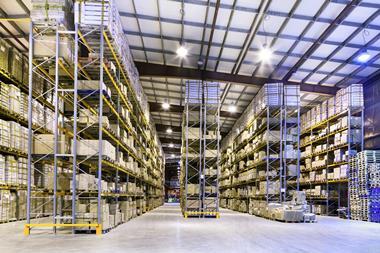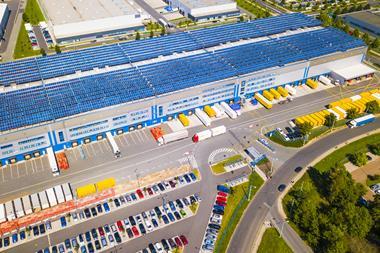A year ago, the industrial and logistics sector (I&L) was riding the crest of a wave. Take-up of industrial properties had reached a record high and supply was at its lowest-ever levels, according to Savills.

Then came a series of economic blows that knocked the sector off course. At the end of April 2022, online giant Amazon reported a drop in sales as shoppers headed back to the high street following the lifting of Covid restrictions.
The fall was viewed as indicative of a general decline in online sales and demand for warehouse space. The news hit the I&L property sector hard, with some listed firms’ share prices dropping by a quarter almost overnight.
The war in Ukraine and the cost-of-living crisis exacerbated the situation. By the end of 2022, there was a sharp decline in I&L investment. According to Savills, investment in I&L assets totalled just £890m in Q4 2022 – 73.1% lower than the Q4 three-year average.
So, what lies ahead for the I&L sector in 2023 and beyond? Property Week caught up with five speakers from this year’s Industrial & Logistics Conference & Showcase to discuss the state of the market and emerging trends.
Positive signs
Kevin Mofid, head of EMEA logistics research at Savills, says despite the recent drop in demand, the market remains in a relatively good place.
“While the second half of 2022 was slower in terms of occupier demand than the market had become accustomed to during the pandemic period, we still saw 48m sq ft of take-up, the third-highest year ever recorded.”
Logistics is an industry that is an engine for UK economic growth
Polly Troughton, St Modwen Logistics
He adds that figures for Q1 2023 are likely to be better than many expected, with Savills tracking more than 5m sq ft of space under offer. Mofid says the majority of that space is existing buildings, with more than two-thirds being speculatively built space.
Fears that vacancy rates could rise sharply as businesses vacate properties to cut costs have so far not been realised either, but lower demand for space has affected rental growth.
“Over the past nine months, the vacancy rate in the market has been trending upwards and now stands at 4.6%, up from a record low of 2.9%, but still well below the 10-year average of 7.4%,” says Mofid.
“However, requirement levels have been trending downwards at a nationwide level. This would suggest that some of the tension that led to amplified rental growth over that past 36 months has lifted and rents will not rise at the levels we have recently seen.”
One I&L firm that has grown rapidly during the recent boom years is urban logistics developer Chancerygate. It has invested around £35m in new sites over the past year and manages £385m of assets across more than five million sq ft of space. Last year, it also entered the European market for the first time since being founded in 1995 with the €4.5m (£4m) acquisition of a five-acre site near Dublin airport.
Chancerygate managing director Richard Bains acknowledges that demand for I&L space might be down generally, but says that not all of the market has experienced a fall.

“While the development pipeline has been negatively affected over the past 12 months, we have more than 3.2m sq ft of urban logistics space under construction, or ready for development, across 24 sites ranging from Bournemouth to Edinburgh.”
He says Chancerygate continues to experience “robust levels of demand” from investors and occupiers wanting grade-A property with excellent ESG credentials. “We expect that this will lead to a pick-up in new developments over the near term,” he says.
Supply challenges remain
Another developer not allowing the downturn to dent its ambitions is St Modwen Logistics, owned by private equity firm Blackstone. Its projects include the £56m development of two new warehouses totalling 450,000 sq ft in Chippenham, Wiltshire.
It also recently acquired a 381,000 sq ft warehouse on the Centrum West Logistics Park in Burton upon Trent, and a 180,400 sq ft distribution unit in Middlemarch near Coventry city centre.
Polly Troughton, managing director at St Modwen Logistics, says that demand for modern logistics and warehouse space remains strong, while “available supply is low”.
However, she believes that the I&L sector faces a number of pressing challenges. “Logistics is an industry that is an engine for UK economic growth, with jobs in the sector adding on average £58,000 per head in gross value added – some 12% higher than the UK average, and rising,” she says.
Shopping habits have changed. We have to rehink city and town centres
Ruth Waring, Women in Logistics
“Despite this, the industry is facing a number of issues that need addressing: the need for a more strategic and regional approach to planning to improve employment land allocation; labour shortages; increasing power requirements; and why design, not offsetting, is key to helping us meet our net zero ambitions.”
Among the trends starting to emerge in the I&L sector is the need for developers to give more back to communities and have a greater social impact in the places where they operate. In the past, developers have been accused of marching into communities, building large-scale structures and moving on without giving much thought to the lasting impact of the development on the community.
Warehouse giant SEGRO is among those changing the way it works with communities. Last year, its Community Investment Plans saw the firm commit to providing tangible economic and social benefits to thousands of people in the communities where it operates.
Paul Dunne, managing director of group operations at SEGRO, says: “Each plan is tailored to meet specific community requirements and will be delivered with the help of local partners and driven by SEGRO employees.
“While the plans and the level of investment are important, more critical is ensuring that they deliver outcomes that will make the biggest positive difference. We felt focusing these outcomes around employment, local economic growth and enhancing local environments was most authentic to our business.”
Other emerging trends include the growth of ultra-urban warehouses – small-scale logistics sites located in densely populated residential areas or city centres.
Central locations
Ruth Waring, a logistics consultant and founder of Women in Logistics, believes we are likely to see more warehouse facilities opening in central locations in the years to come, with car parks and even shopping centres converted into logistics sites.
“Our shopping habits have changed and the way we procure our goods has changed,” she says. “Last-mile solutions may have to be in environments that were previously brownfield sites or not necessarily seen as logistics spaces. We have to rethink our city and town centres. It may well be that some of those things previously used purely for retail, or other urban activity, are just going to have to be rethought.”
Waring says that changing regulations and companies’ own requirements to minimise their environmental impact will also have an effect on how goods are transported and stored in city centres. She cites the example of Newcastle’s recently introduced clean air zone, which applies a charge to high-polluting heavy-goods vehicles.
“There will be very few places left that don’t make it almost financially impossible to drive heavy goods into city centres,” she says.
“[Therefore] you almost must have a hub-and-spoke mechanism where you have a large vehicle doing the trunking and delivering into a satellite [warehouse], because you can’t get that vehicle close enough to where it needs to go.”

Industrial & Logistics Conference & Showcase
Property Week’s annual Industrial & Logistics Conference & Showcase provides a forum for agents, developers, investors and occupiers to come together to discuss the latest trends and insights from across the sector. The event takes place on 3-4 May 2023 at the new location of the Park Plaza, London Victoria.





























No comments yet